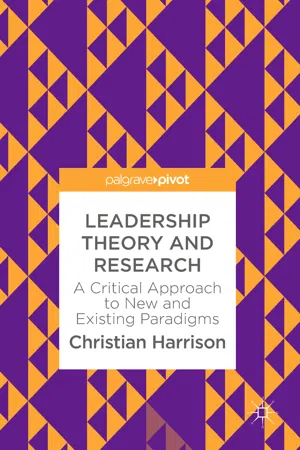Business
Trait Theory of Leadership
The Trait Theory of Leadership suggests that certain innate qualities and characteristics, such as intelligence, confidence, and charisma, are inherent in effective leaders. This theory focuses on identifying and understanding these specific traits in individuals to predict their potential for leadership roles. While it has been criticized for oversimplifying the complexities of leadership, it has influenced the development of leadership assessment tools and selection processes.
Written by Perlego with AI-assistance
Related key terms
4 Key excerpts on "Trait Theory of Leadership"
- eBook - ePub
- Jonathan Gosling, Ian Sutherland, Stephanie Jones(Authors)
- 2012(Publication Date)
- SAGE Publications(Publisher)
competencies . Behaviourist Theories These theories, still regarded as currently useful, concentrate on what leaders actually do rather than on their qualities or characteristics. Different patterns of behaviour are observed and categorized as ‘styles of leadership’, which are then discussed by practicing managers in the field. Some of these ‘styles’ include charismatic leadership, servant leadership and quiet leadership. Situational Leadership This approach (also still widely popular) sees leadership behaviour as determined by the situation in which leadership is being exercised. Some situations may require an autocratic style; others may need a more participative approach. It also suggests that there may be differences in required leadership styles at different levels in the same organization, depending on follower readiness. Contingency Theory This is a refined version of the situational view, focusing on identifying the situational variables (contingencies) which best predict the most appropriate or effective leadership style to fit particular circumstances. Transactional Theory This approach emphasizes the importance of the relationship between leaders and followers, focusing on the mutual benefits derived from a form of ‘contract’ through which the leader delivers rewards or recognition in return for the commitment, loyalty and efforts of the followers. Transformational Theory The central concept here is of follower change, and the role of leadership in transforming the performance of his or her followers, through influences which impact on their growth and personal development. Transactional and transformational leaders are frequently contrasted but they are not mutually exclusive. - eBook - ePub
- Ian O'Boyle, Duncan Murray, Paul Cummins(Authors)
- 2015(Publication Date)
- Routledge(Publisher)
Although early reviews rejected the idea that traits could influence leadership, more recent studies confirm that leaders do differ from non-leaders on a number of traits. This conclusion comes from developments in the field such as the Big Five organising framework and methodological techniques that resulted in a re-emergence and reassessment of previous conclusions regarding trait theories of leadership. Although it is clear that there are no universal traits that differentiate leaders and non-leaders, the possession of certain traits can increase the likelihood that one will emerge as a leader and be an effective leader. Understanding the influence good and bad traits can have on leader emergence and effectiveness is therefore of critical importance.Perhaps most importantly a trait approach to leadership lends itself to the selection, as opposed to the development, of leaders. Leadership theories that focus on leader behaviours and styles, such as transformational leadership, are useful for leadership development as they identify the behaviours that comprise effective leadership and therefore can be learned (e.g. Barling et al., 1996 ; Kelloway et al., 2000 ; Mullen and Kelloway, 2009 ). However, there is little in transformational leadership that would allow organisations to identify who might become a transformational leader or who might benefit most from leadership development. In contrast, trait theories focus on relatively stable and enduring characteristics of an individual. Identifying traits that are reliably associated with leadership effectiveness provides a basis for developing selection systems to identify potential leaders.SUMMARY
Although early trait theories of leadership research received harsh criticisms, advances in the field have led to a reappearance of the approach, supported by an abundance of recent empirical research. Inferences from these reviews support the initial notion that leaders differ from non-leaders on various traits and that most of these traits, at least to some extent, are heritable. The development of the Big Five has contributed significantly to the trait approach and has acted as an organising framework for the copious amount of traits that have been examined in conjunction with leadership. Of the Big Five personality traits, extraversion, conscientious ness and openness to experience are positively related to indices of leadership, whereas neuroticism is negatively related. Likewise, an examination of the Dark Triad traits – narcissism, Machiavellianism and psychopathy – suggests that although they may be effective in specific situations, for the most part they are not considered valuable traits for leaders to possess. In conclusion, given how important good leaders are to organisational outcomes and organisational success, understanding how traits can influence leadership emergence and effectiveness is essential. - eBook - ePub
Leadership Theory and Research
A Critical Approach to New and Existing Paradigms
- Christian Harrison(Author)
- 2017(Publication Date)
- Palgrave Macmillan(Publisher)
2010 ).Skill Theory
Although leadership studies began with the concept of the ‘Great Man ’, in which a leader is seen as born and not made, Katz (1955 ) proposed a shift from a focus on personality traits to an emphasis on skills and abilities of individuals that can be learned and developed (Northouse 2010 ). Therefore, the major difference between the trait approach and the skill approach was that, unlike the traits (which were said to be innate and cannot be learned), skills or competencies could be developed. Katz (1955 ) put forward three skills which he argued were essential to being an effective administrator—technical , human and conceptual skills .More recently, Mumford et al. (2000a ) advanced three key leadership competencies , which are problem-solving, social judgement and knowledge skills. The skill approach, unlike the trait approach, provides a broader perspective on leadership. It shifts the focus on leadership being just for a selected few but to a new mindset that everybody can be a leader if they so desire and are ready to acquire the necessary skills and competencies . But although it claims to be quite different from the trait perspective , the major component of Mumford et al.’s (2000a ) research on leadership skills was individual attributes which are trait -like; hence, the skill -based approach is still trait driven (Northouse 2010 ). In addition, most of the skills originated from research in the army neglecting the entrepreneurial context (Mumford et al. 2000a , b ). The skill perspective is discussed in more detail in Chap. 4 - eBook - ePub
- Jon P. Howell, Isaac Wanasika(Authors)
- 2018(Publication Date)
- Routledge(Publisher)
Despite problems with the early trait research, these categories of leadership traits appear to be helpful for effectiveness in many situations. Few great leaders possessed all the important leader traits, but these leaders all demonstrated characteristics that were essential to succeed in their situation. Leadership traits themselves do not cause an individual to emerge as a leader or to become a great leader. The key traits for a specific leader ship position make it more likely that a leader will take effective action by demonstrating needed leadership behaviors in the situation. A leader who is sociable and controls her emotions will likely be effective at providing needed encouragement and interpersonal support for followers during stressful, threatening episodes that sometimes occur in organizations. Leaders who are intelligent, original, and assertive are more likely to create and instill an inspiring vision and mission for the organization. Leaders who are self-confident, assertive, and energetic will be comfortable in providing directive leadership for followers in solving difficult job or organizational problems. Specific leadership traits can clearly be important preconditions for effective leadership behavior, especially when they are aligned with other variables such as relevant skill for a position or social identity of followers. When a leader possesses the traits needed for a specific position and reflects those traits in her behavior, she is more likely to obtain the trust, respect, and cooperation needed from others for effective group or organizational performance. Recent studies have started to examine the “dark side” of personality that might lead to destructive/toxic leadership.Early Behavioral and Contingency Theories
In the 1950s, several university based research programs began to focus on identifying the most effective behavior patterns of leaders. At first, these programs sought to identify one or two behavior patterns that characterized all effective leaders. This was later described as the “one best way” approach to leadership effectiveness. After numerous investigations, they identified two behavior patterns that seemed especially important. The different researchers used several labels for these two behaviors. One behavior pattern was called consideration, relationship orientation, concern for people , or supportive leader behavior and included showing a concerned and caring attitude toward followers, being friendly, encouraging followers’ feelings of personal worth, and supporting efforts to develop their capabilities. The second leader behavior pattern was called initiating structure, task orientation, concern for production , or directive leader behavior
Learn about this page
Index pages curate the most relevant extracts from our library of academic textbooks. They’ve been created using an in-house natural language model (NLM), each adding context and meaning to key research topics.



